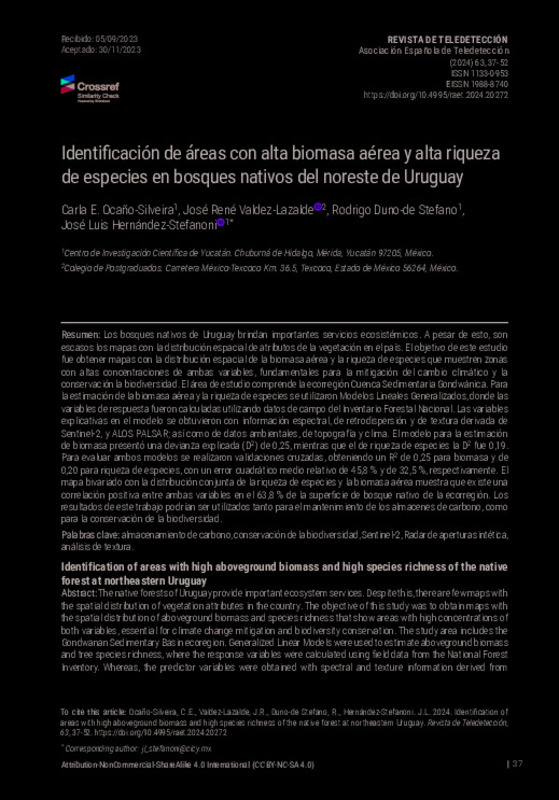|
Resumen:
|
[EN] The native forests of Uruguay provide important ecosystem services. Despite this, there are few maps with the spatial distribution of vegetation attributes in the country. The objective of this study was to obtain ...[+]
[EN] The native forests of Uruguay provide important ecosystem services. Despite this, there are few maps with the spatial distribution of vegetation attributes in the country. The objective of this study was to obtain maps with the spatial distribution of aboveground biomass and species richness that show areas with high concentrations of both variables, essential for climate change mitigation and biodiversity conservation. The study area includes the Gondwanan Sedimentary Basin ecoregion. Generalized Linear Models were used to estimate aboveground biomass and tree species richness, where the response variables were calculated using field data from the National Forest Inventory. Whereas, the predictor variables were obtained with spectral and texture information derived from Sentinel-2, and ALOS PALSAR; as well as environmental, topography and climate data. The biomass estimation model presented an explained deviance (D2) of 0,25, while in the species richness model, the D2 was 0,19. To evaluate both models, cross-validations were carried out, obtaining an R2 of 0.25 for aboveground biomass and 0,19 for species richness, with a relative mean square error of 45,8 % and 32,5 % respectively. The bivariate map with the joint distribution of species richness and aboveground biomass shows that there is a positive correlation between both variables in 63,8 % of the native forest area of the ecoregion. The results of this work could be used for the maintenance of carbon stocks and for the conservation of biodiversity.
[-]
[ES] Los bosques nativos de Uruguay brindan importantes servicios ecosistémicos. A pesar de esto, son escasos los mapas con la distribución espacial de atributos de la vegetación en el país. El objetivo de este estudio fue ...[+]
[ES] Los bosques nativos de Uruguay brindan importantes servicios ecosistémicos. A pesar de esto, son escasos los mapas con la distribución espacial de atributos de la vegetación en el país. El objetivo de este estudio fue obtener mapas con la distribución espacial de la biomasa aérea y la riqueza de especies que muestren zonas con altas concentraciones de ambas variables, fundamentales para la mitigación del cambio climático y la conservación la biodiversidad. El área de estudio comprende la ecorregión Cuenca Sedimentaria Gondwánica. Para la estimación de la biomasa aérea y la riqueza de especies se utilizaron Modelos Lineales Generalizados, donde las variables de respuesta fueron calculadas utilizando datos de campo del Inventario Forestal Nacional. Las variables explicativas en el modelo se obtuvieron con información espectral, de retrodispersión y de textura derivada de Sentinel-2, y ALOS PALSAR; así como de datos ambientales, de topografía y clima. El modelo para la estimación de biomasa presentó una devianza explicada (D2) de 0,25, mientras que el de riqueza de especies la D2 fue 0,19. Para evaluar ambos modelos se realizaron validaciones cruzadas, obteniendo un R2 de 0,25 para biomasa y de 0,20 para riqueza de especies, con un error cuadrático medio relativo de 45,8 % y de 32,5 %, respectivamente. El mapa bivariado con la distribución conjunta de la riqueza de especies y la biomasa aérea muestra que existe una correlación positiva entre ambas variables en el 63,8 % de la superficie de bosque nativo de la ecorregión. Los resultados de este trabajo podrían ser utilizados tanto para el mantenimiento de los almacenes de carbono, como para la conservación de la biodiversidad.
[-]
|









